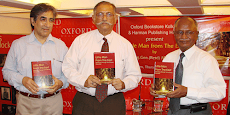 န By Udayan Namboodiri
န By Udayan Namboodiri Major General Manabendra Paul was referred to me by a common friend, Dr. Purabi Roy, a doughty Kolkata-based academician we both take pride in knowing. As he lives in Bangalore and I in Delhi, it was therefore quite a few weeks before we could meet. That happened at the tea room of the India International Centre on a winter's afternoon in January 2009. Handing over the manuscript of his first book, he asked if I would write foreword for it. I took it up with a sense of pride. Here was a man who has seen so much of history first hand, fought wars, and indeed participated in the building and protection of modern INDIA, selecting me as an introducer for his first book. Having authored two books myself over the past 14 years, I had come to absorb the varied feelings that come along with recognition. Sometimes it comes in the form of a reference in another scholar's work; often as media acknowledgement. Being approached by another writer, that too a first-timer, to lend your name as if it matters a fat lot, is salutation that I find vaguely quaint.
Little Man From The East is a multi-layered joie de vivre. As the reminiscences of a soldier, it is exceptional. But it's place as a social documents cannot be overstated. Born into a professional family in undivided Bengal in the 1930s, the writer belongs to a generation that has lived through one of the profoundly dramatic ages in world history. He records the travails of India as a young nation as they touched his own life, without forgetting the individuals who made it a vibrant era, especially for himself. It was the age of Gandhi, Netaji and other makers of our evolving nation. On the other hand there was a grandfather who taught him the values of life, an uncle who took part in the freedom struggle and another who, characteristic of uncles of that age, played the role of a friend-philospher-guide in the concrete jungle of Calcutta in which the young student from Shillong found himself lost. The story of Pauls unfolds through a succession of teachers, friends, colleagues, and, of course, those wonderfully charming Army colonels.
In the second half of 1962, Paul found himself posted to the north-east, not the safest place in the world for a soldier as there loomed at the time the twin threats of Naga-Mizo insurgency and Chinese aggression. It was also a time when his mind was doubtless preoccupied with worry for his young wife who was pregnant with his first daughter. What emotions assaulted his mind when facing the awesome challenge can hardly be imagined by somebody of my generation. Yet, his story, when recounted forty-five years later, is self-effacing and full of pride in the fact that he could be part of the 65 Field Company which participated in the operation against the Chinese under the 11th Infantry Brigade. He recounts the supreme sacrifice of a certain Lieutenant Khan. Tragically, the young officer was not declared 'killed in action' till a year after his death. The double-whammy (the result of a non-performing, self-serving, slothful bureaucracy which caused the Chinese debacle in the first place) was the criminal delay in releasing Lt. Khan's final compensation to his bereaved family.
The story of Maj. Gen. Paul's movement through postings is not about an ordinary soldier's career graph, but also the saga of modern India. The Corps of Engineers of that age took tremendous pride in the institutions its officers and men built around the country, and I am certain that military historians of the future would seek out this book to trace the origins of important facilities like the dry docks in Vishakapatnam or the Tenga Valley Project or the numerous roads, training academies and others that figure within. For his involvement with these important projects, Maj. Gen. Paul was awarded the Vishlsht Seva Medal and was com mended three times by all three Service chiefs — a rare honour. Professional recognition continued to pursue him even after retirement when the late Raja Ramanna, along with Dr R.L. Kapur, invited him to join the National Institute of Advanced Studies, Bangalore.
The scattered reference to historical events that touched his life - Bengal Famine, Partition, Independence movement, corruption, war, etc. - reveal early enough the author's keen sensitivity to the large picture. From page 187 onwards, macro history itself becomes the theme, giving the reader a perspective of history that is so rare to come by in India.
Being a graduate with specialization in History from Presidency College, Kolkata, and a lifelong student of historical non-fiction (about the only acceptable genre for me), I received this sectionwith mixed feelings. Major General Paul manifests a great deal of scholary interest in the history of India and offers a uni-dimensional narrative through an "Awakening" series followed byrandom reflections on the national freedom sttuggle, a phenomenon that doubtless shaped the world view of his generation. That said, I was also left wondering whether it was too uni-dimensional. Yet, as a lifelong campaigner against biased history, I had always felt a big void in the Indian historiography tradition left by state-controlled historians. I always believed thateverybody, whether trained in the craft of the historian or not, has the right to record his interpretation of a common past. To that extent, this book addresses a major need.
Major General Paul's chapter on the 1857 uprising (which he paradoxically titles as both "The Great Sepoy Mutiny" and "The Second Awakening") makes for easy-paced reading as well as somewhat refreshing. His take on 'Netaji' Sub has Chandra Bose is the acknowledgement (significant coming from an Indian Army officer) that the 20th century's most charismatic Indian leader was an instinctive military strategist who successfully raised a new regiment. He quotes Ramchandra Gandhi, the philosopher who was also Mahatma Gandhi's grandson, as conceding that Netaji had shocked the world community for proving India's ability to wage a conventional military war against the British. The combined effect of 'Ahimsa' and conventional battle proved too debilitating for the British Empire and India's freedom followed in the natural course.The 20th Century is often reflected upon as the 'People's Century'. In the United States, Britain, Germany and almost every western country, recording for posterity is a national mission to which everybody contributes equal mite. In my view, that passion for seeking the national identity through micro-macro visitations to the past, lies at the source of their economic prosperity. This book left me wistful on the lonesome road that story-tellers have to take in this country. I wish Little Man From The East all success.
[Udayan Namboodiri is the author of St. Xavier's — the Making of a. Calcutta Institution (Penguin Viking, 1995 and Bengal's Night Without End, India First Foundation, 2006). He is also a career journalist, having served in 8 major national media organizations in 18 countries over the past 23 years. He is now heading his own Environment Movement while also serving The Pioneer and National Council of Applied Economic Research in consultative capacities. He lives in New Delhi with his wife and two children]





No comments:
Post a Comment